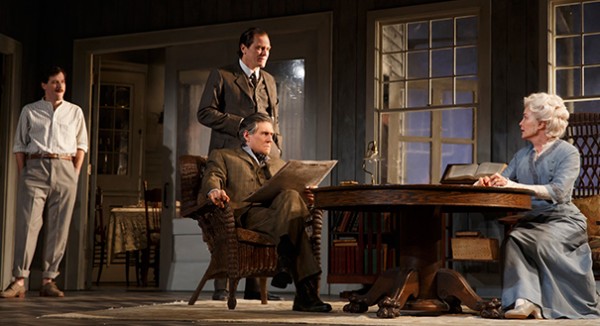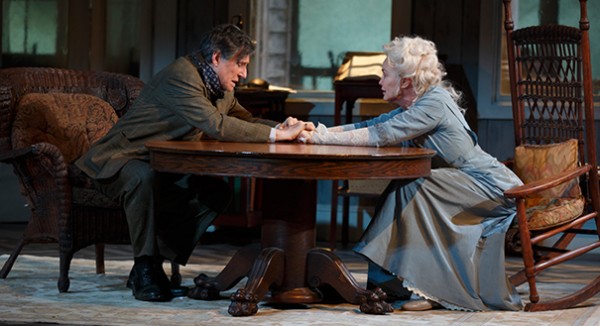
The Tyrone family battles its inner and outer demons in Roundabout revival of Eugene O’Neill masterpiece (photo by Joan Marcus)
American Airlines Theatre
227 West 42nd St. between Broadway & Eighth Ave.
Tuesday – Sunday through June 26, $67-$147
212-719-1300
www.roundabouttheatre.org
As the audience enters the American Airlines Theatre to see the Roundabout revival of Eugene O’Neill’s Pulitzer Prize-winning drama Long Day’s Journey into Night, a white curtain billows ominously from the right side of the set, blown by the wind from an offstage shore. It’s as if we’re being warned that what we’re about to see is a kind of ghost story, and that’s precisely what we witness over the next three hours and forty-five minutes, an intense tale told as if the dysfunctional Tyrone family must relive their personal horrors over and over again, continually hiding from the truths that overwhelm them. Sixty-five-year-old patriarch James Tyrone (Gabriel Byrne) is a miserly, well-known actor who is fond of the bottle and the small tract of land that he owns. He is still in love with his wife, the fifty-four-year-old Mary (Jessica Lange), a morphine addict who has been in and out of sanatoriums and is struggling to deal with reality. Their older son, thirty-three-year-old Jamie (Michael Shannon), is a brash, ne’er-do-well philanderer and would-be actor always at odds with his father. And the younger son, twenty-three-year-old Edmund (John Gallagher Jr.), is a more sensitive soul who is suffering from an illness that might be consumption. It’s August 1912, and the Tyrones are at their summer home on the beach. “I can’t tell you the deep happiness it gives me, darling, to see you as you’ve been since you came back to us, your dear old self again,” James tells Mary, who has recently returned from her latest rehab stint. James and Jamie are trying to keep the severity of Edmund’s illness from Mary, fearful that the truth will send her back to her drug of choice. “It’s a relief to hear Edmund laugh. He’s been so down in the mouth lately,” she says early on, which James ignores resentfully. Soon James and Jamie are having one of their regular arguments, which upsets Edmund and Mary. “What’s all the fuss about? Let’s forget it,” Jamie says. “Yes, forget! Forget everything and face nothing!” James shouts back, summarizing the general Tyrone philosophy. Meanwhile, Mary compares James’s snoring to the foghorn that keeps her awake at night, as if the harsh sound is a wake-up call, warning of dire things to come that all ignore. As they await the verdict from Doc Hardy regarding Edmund’s illness, the ghosts continue to hover over this doomed family, unable to save themselves from their sad destiny.

James Tyrone (Gabriel Byrne) and wife Mary (Jessica Lange) hold on to each other for dear life in LONG DAY’S JOURNEY INTO NIGHT (photo by Joan Marcus)
Completed in 1942 but not published and performed until 1956, three years after O’Neill’s death at sixty-five, Long Day’s Journey into Night is a semiautobiographical look at the playwright’s own family over the course of one very long day, from 8:30 in the morning to midnight. It takes a while to get used to accepting the cast as the Tyrone family; while Byrne is around the right age for James, Mary is supposed to be eleven years younger but Lange is actually a year older than Byrne, and Shannon and Gallagher at first seem completely miscast, but they both eventually settle into their roles. Director Jonathan Kent (Hamlet, Man of La Mancha) makes the most of Tom Pye’s (The Testament of Mary, Fiddler on the Roof) inviting yet haunting set, Natasha Katz’s (An American in Paris, Aida) appropriately moody lighting, and Clive Goodwin’s (The Glass Menagerie, Once) menacing sound design, keeping the audience on edge as the intense drama unfolds. Byrne (A Moon for the Misbegotten, A Touch of the Poet) and Lange (A Streetcar Named Desire, The Glass Menagerie) ultimately form a stirring James and Mary, their love complicated by suspicion and doubt, in parts previously played by such pairs as Robert Ryan and Geraldine Fitzgerald, Laurence Olivier and Constance Cummings, Jason Robards and Zoe Caldwell, Robards and Colleen Dewhurst, Jack Lemmon and Bethel Leslie, Brian Dennehy and Vanessa Redgrave, and, in 2000, Charles Dance and Lange. The cast also includes Colby Minifie (The Pillowman, Punk Rock) as Cathleen, the Tyrones’ young maid who speaks her mind when she has the chance. “A drop now and then is no harm when you’re in low spirits, or have a bad cold,” she says to Edmund as the two steal a drink from one of James’s closely watched bottles. Of course, drinking can actually do a lot of harm, as the Tyrones, and O’Neill himself, are well aware. This Roundabout revival is a powerful production of one of America’s signature plays, once again justifying its position in the pantheon alongside such other towering achievements as Arthur Miller’s Death of a Salesman, Tennessee Williams’s A Streetcar Named Desire, and Edward Albee’s Who’s Afraid of Virginia Woolf?